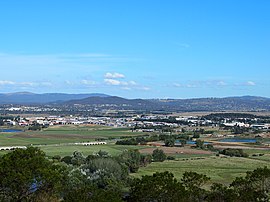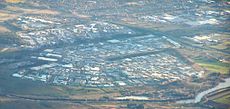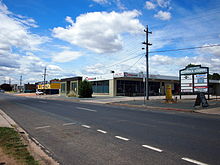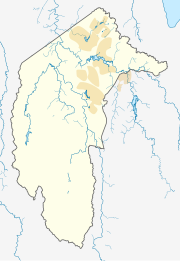Fyshwick, Australian Capital Territory
| Fyshwick Canberra,Australian Capital Territory | |||||||||||||||
|---|---|---|---|---|---|---|---|---|---|---|---|---|---|---|---|
 Fyshwick viewed from Mount Pleasantc.2013 | |||||||||||||||
| Coordinates | 35°19′44″S149°10′26″E/ 35.329°S 149.174°E | ||||||||||||||
| Population | 52 (SAL2021)[1] | ||||||||||||||
| Gazetted | 20 September 1928 | ||||||||||||||
| Postcode(s) | 2609 | ||||||||||||||
| Elevation | 577 m (1,893 ft) | ||||||||||||||
| Area | 9.76 km2(3.8 sq mi) | ||||||||||||||
| Location |
| ||||||||||||||
| District | South Canberra | ||||||||||||||
| Territory electorate(s) | Kurrajong | ||||||||||||||
| Federal division(s) | Canberra | ||||||||||||||
| |||||||||||||||
Fyshwick(/fɪʃwɪk/) is a retail and light industrial suburb ofCanberra,Australia, east of the South Canberra district. At the2016 census,Fyshwick had a population of 56.[2]
It has many motor vehicle dealers, stores selling home furnishings and hardware, and stores that sell goods wholesale. Fyshwick also has theCanberra Outlet Centreand theFyshwick Fresh Food Markets.There are also some cafés and fast-food outlets.
It was named after SirPhilip Fysh,aTasmanianpolitician who assisted in bringing about Australia's Federation. The suffix "wick", from Old English, means "dwelling place" – and, by extension, "village" or "district". Its streets are named after Australia's industrial towns and regions – for example,Mount Isais represented by Isa Street andTownsvilleis represented by Townsville Street.[3]
Fyshwick is also known for its adult entertainment industry. Fyshwick andMitchellare the two places in the ACT where strip clubs andbrothelsmay operate legally.Prostitutionin the ACT was decriminalised in 1992, but strip clubs and brothels are restricted to those two suburbs. Fyshwick was also known for firework retailers before their 2009 ban from public purchase in theAustralian Capital Territory.
The only railway line into Canberra runs through the middle of Fyshwick, dividing the area into halves. Ipswich and Newcastle Streets as well as theMonaro Highwaycross the railway line, uniting both halves of Fyshwick.
The Fyshwicksewage treatmentworks was built in 1967 to treatwaste waterthat could not easily be pumped to the other side of Canberra. It is now used to treat industrial waste water, which is then used to water theDuntroongrounds andgolf course.[4][5]
History
[edit]One noteworthy portion of Fyshwick, located between the railway line and Canberra Avenue, was built as aninternment campduring early 1918. It was known as the Molonglo Internment Camp, although it was also referred to as aconcentration camp.The site was intended to accommodate 3,500 German and Austrian nationals being expelled from China, however once the camp had been established in May 1918 these internees were no longer destined for Molonglo. Instead, the camp housed 150 internees transferred from the Bourke Camp inNew South Wales.The camp was closed in late 1919 after the internees were deported to Germany. Most of the camp's buildings were sold off, with the remaining buildings being converted to house construction workers, some of whom were unemployed returned servicemen. It was then called Molonglo Settlement.[6]Gradually the camp buildings were moved to other camp sites around Canberra and the roads used to service the camp became the first streets of Fyshwick.[7][8]

The internment camp's hospital at what is now Tennant Street became the Molonglo Public School. This school closed in 1942 and then became a naval auxiliary wireless station. This operated until 1946. The station consisted of one wooden T-shaped building and afibromess hall. This station operated the receivers for the strategic fixed radio links to Australia forWhitehall,Halifaxand Bombay Fort. During this period 14WRANSoperated the equipment. Marion Stevens was a Petty Officer in charge of the station from 1943 to 1946. She was notable as the only woman in charge of a transmitting station.
The station was part of theHarmanradio network, as was connected via a landline to the main Harman site. Equipment at the Molonglo station includedteleprintersfor use when reception was good. During poorerradio propagationperiods morse coderadiotelegraphyhad to be used.
After the war the Molonglo station became a dog training school. In the early 1980s the buildings were demolished.
Geology
[edit]
Most of the north of Fyshwick is underlain by Canberra Formation, calcareousshale. On top of this to the east and west of Jerrabomberra creek areTertiarypebble gravels, and alsoquaternaryalluvium. There are twoandesitedykes intruded across Gladstone Street.
South of the South Fyshwick fault is the daciticandesiteof the Ainslie Volcanics.
The South Fyshwick Fault starts in Narrabundah, runs east from Lithgow St to Tennant Street, crosses the Molonglo river and heads north east to Dundee Hill to join Sullivans Fault.[9]
Education
[edit]Fyshwick residents get preference for:[10]
- A shared Priority Enrollment Area (PEA) of Forrest Primary and Red Hill Primary
- Telopea Park School(for high school)
- Narrabundah College
References
[edit]- A History of HMAS Harman and its people: 1943–1993,by Lieutenant Annette Nelson, RAN, Canberra 1993, pub DC-C Publications.
Footnotes
[edit]- ^Australian Bureau of Statistics(28 June 2022)."Fyshwick (suburb and locality)".Australian Census 2021 QuickStats.Retrieved28 June2022.
- ^Australian Bureau of Statistics(27 June 2017)."Fyshwick (state suburb)".2016 Census QuickStats.Retrieved28 June2017.
- ^"Suburb Name search results".ACT Environment and Sustainable Development. Archived fromthe originalon 27 February 2014.Retrieved9 February2014.
- ^"Actewagl.com.au".Archived fromthe originalon 13 April 2004.Retrieved31 October2004.
- ^Actewagl.com.au
- ^"Canberra Camps: Molonglo Settlement"(PDF).Retrieved18 April2021.
- ^"No 1 Labourers' Camp (c1922-1928) FCT (also known as Daniel's No 1 after Herbert Daniel, Mess Caterer)".hotkey.net.au.Retrieved19 November2010.
- ^Alan Foskett."The Molonglo internment Camp"(PDF).Archived fromthe original(PDF)on 24 October 2009.Retrieved19 November2010.
- ^Henderson G A M and Matveev G, Geology of Canberra, Queanbeyan and Environs 1:50000 1980.
- ^"Priority Enrolment Areas 2015 by Suburb"(Archive). Education Directorate, Australian Capital Territory. Retrieved on 8 February 2016.



